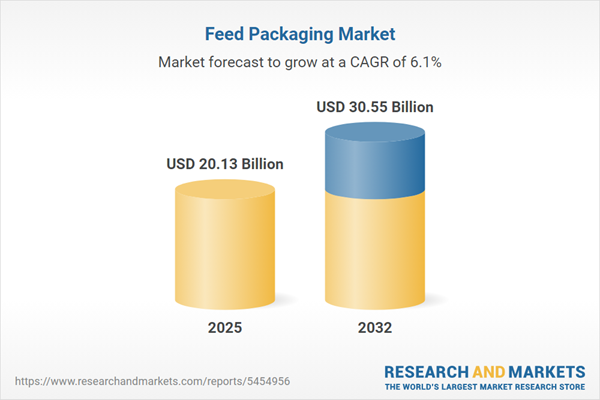Speak directly to the analyst to clarify any post sales queries you may have.
The global feed packaging market is rapidly evolving as sustainability, technological innovation, and policy compliance become central to value chain strategies. Companies are actively seeking competitive advantages through smarter, greener packaging solutions tailored to diverse end-use requirements.
Market Snapshot: Global Feed Packaging Market
The Feed Packaging Market grew from USD 18.96 billion in 2024 to USD 20.13 billion in 2025. The sector is forecast to expand at a CAGR of 6.14%, reaching USD 30.55 billion by 2032.
Accelerated by heightened environmental expectations and digital integration, the market is at a pivotal stage, with ongoing innovation in materials, production processes, and supply chain connectivity shaping the competitive landscape. As regulatory mandates tighten across global regions, feed producers and packaging suppliers are prioritizing adaptability, traceability, and operational efficiency.Scope & Segmentation
- Material Types: Composite, Jute, Paper, Plastic (HDPE, LDPE, PP)
- Container Types: Bulk Container, Open Mouth Bag, Pouch, Valve Bag
- Distribution Channels: Offline, Online
- End Uses: Aquaculture (Fish Feed, Shrimp Feed), Cattle (Beef, Dairy), Pets (Cat Feed, Dog Feed), Poultry (Broiler Feed, Layer Feed), Swine (Grower Feed, Piglet Feed)
- Regions: Americas (United States, Canada, Mexico, Brazil, Argentina, Chile, Colombia, Peru), Europe, Middle East & Africa (United Kingdom, Germany, France, Russia, Italy, Spain, Netherlands, Sweden, Poland, Switzerland, United Arab Emirates, Saudi Arabia, Qatar, Turkey, Israel, South Africa, Nigeria, Egypt, Kenya), Asia-Pacific (China, India, Japan, Australia, South Korea, Indonesia, Thailand, Malaysia, Singapore, Taiwan)
- Featured Companies: Amcor plc, Berry Global Group, Sealed Air Corporation, Sonoco Products Company, Mondi plc, WestRock Company, Smurfit Kappa Group plc, DS Smith plc, Huhtamaki Oyj, Constantia Flexibles GmbH
Key Takeaways
- Sustainability imperatives are accelerating the use of renewable, recyclable, and biodegradable feed packaging materials, influencing product design and supply chain partnerships.
- Digital technologies such as smart labeling and IoT sensors support greater transparency, traceability, and operational control throughout the packaging lifecycle.
- Circular economy principles are gaining momentum, with closed-loop systems fostering material recovery, reuse, and integration of eco-design features.
- Consumer expectations and regional regulations are driving the adoption of tailored packaging formats, from moisture-resistant aquaculture sacks to resealable pet food pouches.
- Strategic investments in flexible production and digital connectivity enable companies to respond quickly to shifting market demands and regulatory frameworks.
- Collaboration across the value chain is enhancing the development of hybrid materials and advancing sustainability initiatives.
Tariff Impact: U.S. Measures and Global Supply Chains
Scheduled U.S. tariffs for 2025 are expected to reshape feed packaging supply chains, especially for raw materials such as high-density polyethylene and polypropylene. This regulatory shift will require producers to reassess sourcing strategies, explore local alternatives, and adjust operations to manage new price pressures and logistics realignments. The evolving landscape is expected to intensify nearshoring and collaborative material development, as companies seek to balance cost and resilience under new tariff frameworks.
Methodology & Data Sources
This report utilizes a mixed-methods approach, combining primary research through interviews with industry leaders and onsite assessments, along with secondary analysis of regulatory filings, technical reports, and trade publications. Data validation included qualitative and quantitative cross-verification, benchmarking, peer review, and expert consultation to ensure robust findings and actionable insights.
Why This Report Matters
- Enables informed decision-making by mapping key drivers, opportunities, and risks across global feed packaging markets.
- Delivers an in-depth evaluation of trends affecting material innovation, supply chain design, and sustainability compliance.
- Supports executives in developing strategies that align with evolving regulations, technology adoption, and competitive priorities.
Conclusion
The global feed packaging sector is transforming as sustainability, technology, and regulation converge. Organizations that actively realign portfolios and invest in co-innovation will be positioned to lead in an increasingly complex, opportunity-rich market landscape.
Additional Product Information:
- Purchase of this report includes 1 year online access with quarterly updates.
- This report can be updated on request. Please contact our Customer Experience team using the Ask a Question widget on our website.
Table of Contents
3. Executive Summary
4. Market Overview
7. Cumulative Impact of Artificial Intelligence 2025
Companies Mentioned
The companies profiled in this Feed Packaging market report include:- Amcor plc
- Berry Global Group, Inc.
- Sealed Air Corporation
- Sonoco Products Company
- Mondi plc
- WestRock Company
- Smurfit Kappa Group plc
- DS Smith plc
- Huhtamaki Oyj
- Constantia Flexibles GmbH
Table Information
| Report Attribute | Details |
|---|---|
| No. of Pages | 183 |
| Published | November 2025 |
| Forecast Period | 2025 - 2032 |
| Estimated Market Value ( USD | $ 20.13 Billion |
| Forecasted Market Value ( USD | $ 30.55 Billion |
| Compound Annual Growth Rate | 6.1% |
| Regions Covered | Global |
| No. of Companies Mentioned | 11 |









